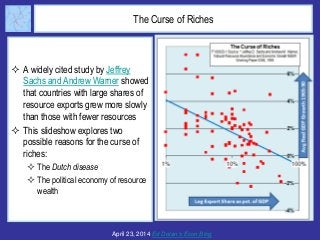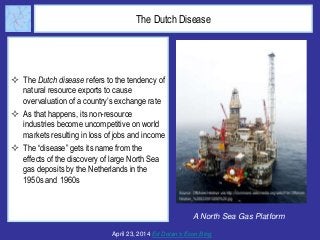The Curse of Riches: Resource Wealth and Social Progress
- 1. Economics for your Classroom Ed Dolan’s Econ Blog The Curse of Riches: Resource Wealth and Social Progress April 23, 2014 Terms of Use: These slides are provided under Creative Commons License Attribution—Share Alike 3.0 . You are free to use these slides as a resource for your economics classes together with whatever textbook you are using. If you like the slides, you may also want to take a look at my textbook, Introduction to Economics, from BVT Publishing.
- 2. The Curse of Riches In the popular imagination, abundant natural resources are a great boon The reality is often different—many countries that are rich in natural resources are economic basket cases Meanwhile economies like Japan, Taiwan, and Hong Kong prosper with few natural resources to draw on April 23, 2014 Ed Dolan’s Econ Blog Gas Flaring in the Niger Delta
- 3. The Curse of Riches A widely cited study by Jeffrey Sachs and Andrew Warner showed that countries with large shares of resource exports grew more slowly than those with fewer resources This slideshow explores two possible reasons for the curse of riches: The Dutch disease The political economy of resource wealth April 23, 2014 Ed Dolan’s Econ Blog
- 4. The Dutch Disease The Dutch disease refers to the tendency of natural resource exports to cause overvaluation of a country’s exchange rate As that happens, its non-resource industries become uncompetitive on world markets resulting in loss of jobs and income The “disease” gets its name from the effects of the discovery of large North Sea gas deposits by the Netherlands in the 1950s and 1960s April 23, 2014 Ed Dolan’s Econ Blog A North Sea Gas Platform
- 5. Effects of Resource Exports on Exchange Rates This figure shows supply and demand of Norwegian krone (NOK) on the foreign exchange market Suppose the initial exchange rate is 1 NOK = 0.10 USD A large offshore oil discovery by Norway increases exports The increased sales of oil, in turn, generate new demand for krone The demand curve shifts to the right and the exchange rate appreciates to 0.14 USD/NOK (point E1) Norway develops the Dutch disease as producers of Norwegian fish, cheese, and manufactured goods find they are less competitive on world markets April 23, 2014 Ed Dolan’s Econ Blog
- 6. Central Bank Intervention to Offset Appreciation To prevent unwanted appreciation of the krone, the Norwegian central bank could issue new krone and use them to buy dollars on foreign exchange markets The increased supply of krone would offset the effect of increase demand and partly or wholly offset the upward pressure on the value of the Norwegian currency The new equilibrium would be at E2 instead of E1 April 23, 2014 Ed Dolan’s Econ Blog
- 7. Risk of Inflation However, massive purchases of dollars by the central bank would flood Norway with new krone, risking an increase in inflation As inflation drove up prices and wages, producers of Norwegian good would find it harder to compete on world markets, despite stabilization of the exchange rate Conclusion: Intervention by the central bank can stabilize the nominal exchange rate but it cannot prevent the Dutch disease—it only changes the form taken by the disease April 23, 2014 Ed Dolan’s Econ Blog
- 8. Fighting the Dutch Disease with a National Wealth Fund A better way to fight the Dutch disease is to invest part of the dollars earned from sale of oil in a national wealth fund Doing so absorbs part of the increased demand for dollars, reducing upward pressure on the krone (point E3 instead of E1) The national wealth fund invests in bonds or other assets that earn income for the future Income or principle from the national wealth fund can be spent during a temporary economic downturn or spent in the future after oil resources are exhausted April 23, 2014 Ed Dolan’s Econ Blog
- 9. Currency Overvaluation and Purchasing Power Parity One way to tell whether a country’s currency is over- or undervalued is to look at its per capita GDP, in dollars, adjusted for the cost of living Economists call this GDP stated at purchasing power parity (PPP) If a country’s cost of living is low, its per capita GDP stated at PPP is higher than its per capita GDP stated at the market exchange rate. That suggests the currency is undervalued If it’s cost of living is high, its per capita GDP stated at PPP is lower than when stated at the market rate. It’s currency is overvalued April 23, 2014 Ed Dolan’s Econ Blog Examples: • Norway’s per capita GDP converted to dollars at the market rate is $100,000 but its cost of living is high. Measured at PPP, its per capita GDP is $55,000 • India’s per capita GDP converted at the market rate is about $1,500 but its cost of living is relatively low. Measured at PPP, its per capita GDP is $4,000.
- 10. Purchasing Power Parity and Per Capita GDP In this chart, a country whose per capita GDP is the same at the market rate and PPP falls on the diagonal line. (The US is on the line by definition) Countries below the line have currencies that are overvalued relative to PPP On average, wealthy countries tend to have currencies that a overvalued and poor countries tend to have currencies that are undervalued relative to PPP, as shown by the dotted trend line April 23, 2014 Ed Dolan’s Econ Blog
- 11. Overvaluation of Currencies of Wealthy Resource Exporters This version of the diagram adds 11 major resource exporting countries, shown as red diamonds The wealthiest of these resource exporters have currencies that are more overvalued than we would expect based on their per capita GDP alone (that is, they are below the dotted trendline) Conclusion: These wealthy resource exporters are the most vulnerable to the Dutch disease April 23, 2014 Ed Dolan’s Econ Blog
- 12. The Political Economy of the Resource Curse Resource wealth can undermine a country’s political economy in a way that adds to the resource curse Main focus of political activity is to obtain a share of resource wealth Widespread corruption at all levels of government Neglect of conditions required for growth of non-oil sector Short political time horizon may neglect long- term investment even in resource sector Highly unequal distribution of wealth April 23, 2014 Ed Dolan’s Econ Blog Demonstrators in Venezuela protest corruption and economic mismanagement
- 13. The Social Progress Index A country’s GDP can be considered an input to a country’s social welfare The Social Progess Index (SPI) measures outputs such as health, education, access to information, personal freedom, and good governance April 23, 2014 Ed Dolan’s Econ Blog To view or download the complete social progress index, visit www.socialprogressimperative.org
- 14. The Social Progress Index and GDP On the whole, higher “inputs” of GDP give higher “outputs” on the social progress index The trendline shows the average relationship The relationship is not completely tight. It is easy to find pairs of countries where one has higher GDP and lower SPI score The relationship is nonlinear. Lower-income countries get more social progress per added dollar of GDP April 23, 2014 Ed Dolan’s Econ Blog
- 15. The Social Progress Index and GDP for Resource Exporters This chart adds eleven large resource exporters (red diamonds) On average, the resource exporters get less social progress per dollar of added GDP than other countries Three wealthy countries, Canada, Australia and Norway are exceptions to this pattern April 23, 2014 Ed Dolan’s Econ Blog
- 16. How Do Some Countries Escape the Curse of Riches? How do some countries escape the curse of riches? Countries like Australia, Canada, and Norway developed institutions of political democracy, civil society, and rule of law before they became wealthy resource exporters Their early development benefitted from natural resource in the form of farmland, forests, and fisheries Unlike “point-source” resources such as oil and ores, the outputs from farms, forests, and fisheries are widely owned, hard to monopolize, and less likely to lead to corruption of political life April 23, 2014 Ed Dolan’s Econ Blog Australian farm scene, 1872
- 17. Summary: The Curse of Riches Resource wealth, especially point- source resources such as oil and ores, are sometimes more of a curse than a blessing The Dutch disease, which acts through overvalued exchange rates, seems to be a greater problem for wealthy resource exporters The political economy of the resource curse seems to be a greater problem for lower income resource exporters The most fortunate countries are those who developed democratic institutions before they became wealthy and manage their resource wealth wisely April 23, 2014 Ed Dolan’s Econ Blog
- 18. Click here to learn more about Ed Dolan’s Econ texts or visit www.bvtpublishing.com For more slideshows, follow Ed Dolan’s Econ Blog Follow @DolanEcon on Twitter


















